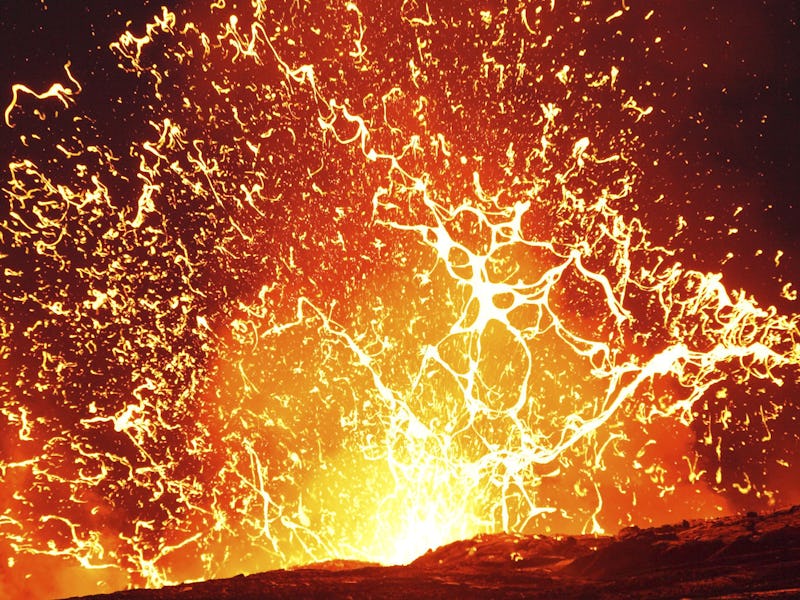No, the 'Yellowstone Lava Geyser' Isn't Erupting Right Now
Even it were, this wouldn't mean an impending mega-eruption.

The Yellowstone supervolcano is an active geological beast, but contrary to some nonsense Facebook posts, the volcano was not gushing lava this weekend and hasn’t spewed any molten rock for 70,000 years.
Fears of a mega-eruption were stoked on social media after Thursday’s 5.8 magnitude earthquake hit about 230 miles from Yellowstone National Park. But this quake, while large for the region, was irrelevant to Yellowstone’s subterranean volcano. Such a temblor would not cause any lava to spew from the park’s forested ground, nor would it invite a catastrophic eruption.
In an egregious show of fake news, the “Casper Planet” Facebook page showed an image of lava violently spraying out of the earth, accompanied by thick smoke, and related this to the recent earthquake. This was laughable bunk for a variety of reasons.
The image shown had an ocean in the background. This was a shot of Hawaii’s Kilauea volcano, which has been gently erupting since the early 1980s. Kilauea is one of the most active volcanoes on Earth, but this doesn’t mean it’s deadly (unless you get too close). Hawaiian volcanoes typify a volcano that gently gushes lava and builds land, rather than erupting explosively, like Mount St. Helens or Mt. Vesuvius, which blow up mountains and bury cities. But when Kilauea’s 1,500-degree lava meets the 75-degree Pacific Ocean, it can burst into smoke.
The image posted by the Facebook page "Casper Planet" attempts to convince people that Yellowstone was spitting out lava, which it wasn't.
During a July 7 Facebook Live webcast, Yellowstone National Park geologist Jeff Hungerford was asked if the quake could have any effect upon the supervolcano. His response:
“Not really because it’s in different terrain – it’s what we call a tectonic event up there. It’s in different types of rock, and it’s not related to the volcanic system here.”
The quake, in short, was volcanically meaningless. It involved the slipping and sliding of massive slabs of rock along the Earth’s fractured crust in a disparate region unassociated with Yellowstone.
A lava-less Yellowstone National Park
Lava has spewed out of Yellowstone in the past and left an abundance of dried lava all over the park. But these gushing-lava events are different than the ominous mega-eruptions of the past, of which there have been three in the past 2.1 million years. If lava were to rush out of the ground at Yellowstone, it might present a threat to nearby communities if it flowed in that direction, or it could snake through the park’s wild canyons, causing bears and deer to flee the sizzling molten rock. The effects cannot be predicted, but the lava rivers, however frightful, wouldn’t affect nor annihilate millions of North Americans, like the feared post claims.
When it does come, scientists like Hungerford expect the volcano to give weeks or years of advanced notice, in the form of incessant quaking and collapsing land. It won’t be a surprise.
Such an eruption, however, is expected to bring untold devastation to the United States, so it’s good that the U.S. Geologic Survey and National Park Service are keeping a watchful eye. Yellowstone’s past eruptions are believed to have blasted out over 240 cubic miles of magma. By comparison, the catastrophic Mt. Saint Helens eruption ejected just 0.3 cubic miles of magma.
Although Yellowstone National Park is rumbling all the time, with between 1,000 and 3,000 quakes a year, it’s unlikely that you’ll ever feel any of these minuscule events, unless, says Hungerford, you’re fortunate.
“Recognize that you might feel a little earthquake, if you’re lucky,” he said.